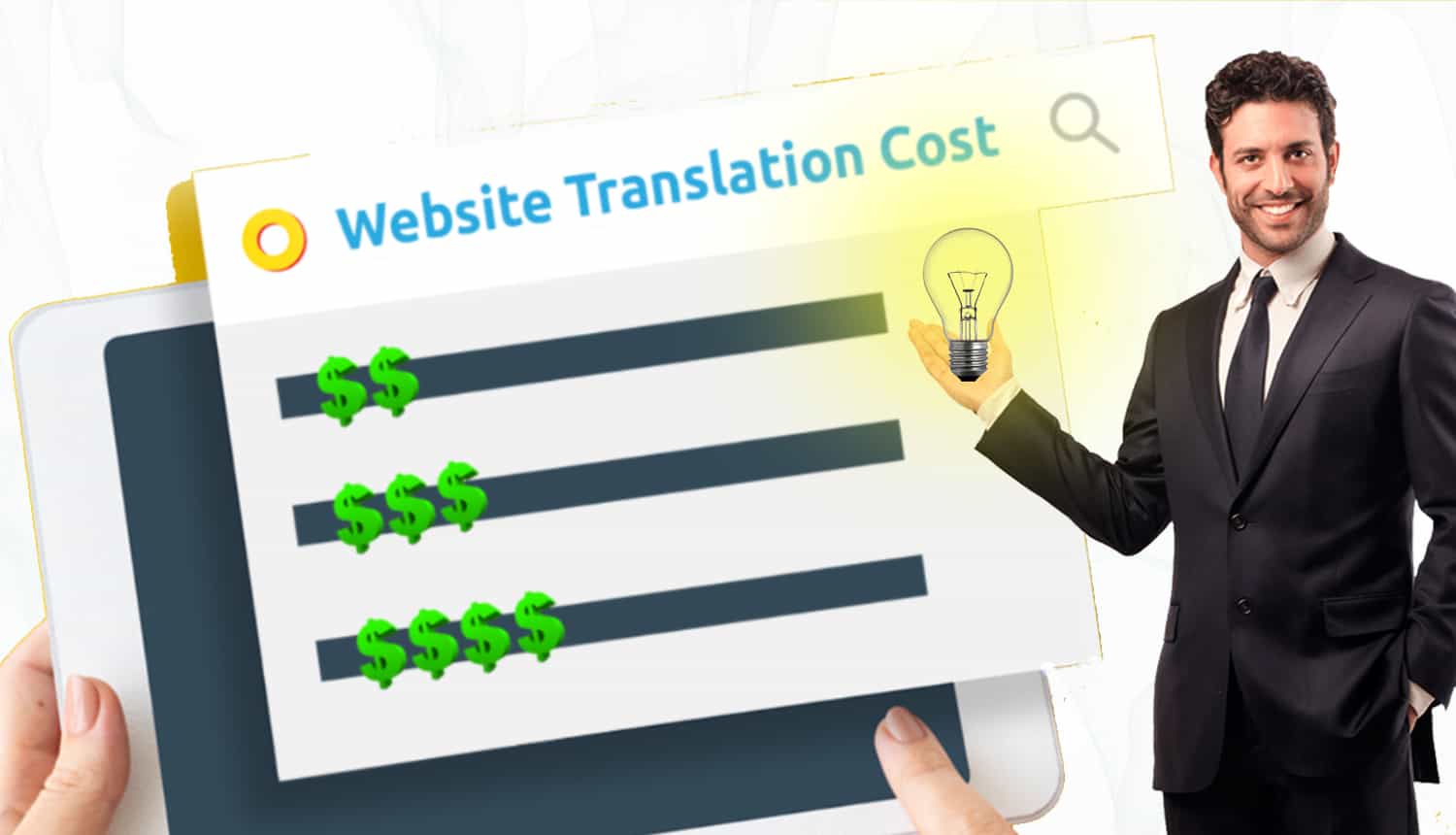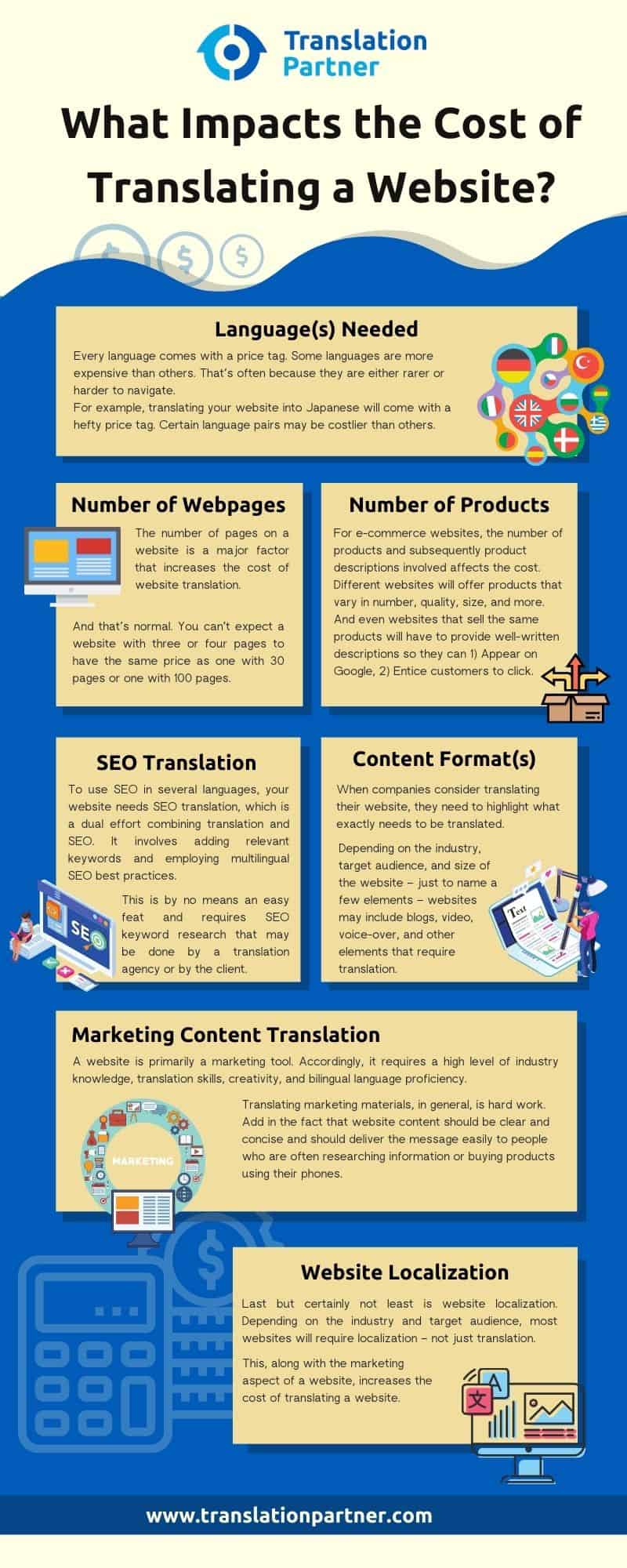These 7 factors play a big role in the cost of website translation

Website translation may have been uncommon 20 years ago but now it’s more relevant and required than ever.
For starters, e-commerce businesses are becoming global. COVID-19 may have hurt small businesses but it’s given e-commerce and online-buying habits a massive boost.
In addition, people within the same country – especially in Europe, the Middle East, and Africa (EMEA) region – are speaking and searching the web in multiple languages.
Recent data has found that 51% of Italian e-commerce firms were using multilingual websites in 2021. (Statista)
Last year, English was the most spoken language worldwide with 1.35 billion speakers, followed by Chinese Mandarin with 1.12 billion speakers. (Statista)
Hindi, Spanish, and (Standard) Arabic ranked third, fourth, and fifth with 600 million, 543 million, and 274 million, respectively.
But translating your website and in some cases localizing it doesn’t come free or cheap. Yes, there are cheap offerings but it’s unlikely you’ll be able to make decent sales with a cheap translation.
In this article, we’re going to focus on the top elements or factors that affect the cost of website translation.
Why website translation is important
Before we focus on what affects the price of getting your website translated, let’s first look at why website translation and localization are becoming important these days.
Whether you’re using an e-commerce website or a service site, one of the top benefits of translating your website into different languages is expanding your customer base.
Using website translation, you can expand your audience beyond your geographical location.
In addition to expanding outside of your region or country, translating your website can help you reach more people in the same country.
You’ll often see this in countries that suffered from colonialism like most North African countries or those that have a large number of immigrants.
For example, Turkey has a large population, but it’s also become home to tens of thousands of Syrians over the past several years, resulting in demand for Arabic and English translation.
Similarly, in Egypt and the UAE, where the local language is Arabic, you’ll find many English-language speakers. In the UAE, both expatriates and Emiratis speak English fluently, while in Egypt, private education is giving more focus to the English language over Arabic.
Translating your website into two languages helps you connect with these different audiences within the same country.
Another major benefit of website translation is search engine optimization (SEO).
As an e-commerce business, you add tweaks like keywords and meta descriptions to help your products rank on Google.
The interesting thing about SEO is that it allows you to rank your products in different languages.
For example, if you have an online store that supports English and German, you can rank the same product in the two languages, which means more exposure for you.
One of the biggest benefits of translating your website is staying ahead of your competitors. Whether they’re thinking of translating their website or e-commerce store or not, you can take the first step and stay ahead of them.
This will help you attract your competitors’ customers who are looking for the same products in different languages, while also giving you precedence.
What impacts the cost of translating a website?
Now that we’ve covered the top benefits that come with translating your website into different languages, let’s look at the elements that impact the cost of website translation.

1) Language(s) needed
Every language comes with a price tag.
Some languages are more expensive than others. That’s often because they are either rarer or harder to navigate.
For example, translating your website into Japanese will come with a hefty price tag.
Certain language pairs may be costlier than others.
2) Number of webpages
The number of pages on a website is a major factor that increases the cost of website translation.
And that’s normal. You can’t expect a website with three or four pages to have the same price as one with 30 pages or one with 100 pages.
3) Number of products
For e-commerce websites, the number of products and subsequently product descriptions involved affects the cost.
Different websites will offer products that vary in number, quality, size, and more. And even websites that sell the same products will have to provide well-written descriptions so they can 1) Appear on Google, 2) Entice customers to click.
Naturally, a website that offers 20 products will not be priced the same way as one with 100 or 1000 products.
4) SEO translation
For a website, web page, or product to rank on Google, it needs SEO.
To use SEO in several languages, your website needs SEO translation, which is a dual effort combining translation and SEO. It involves adding relevant keywords and employing multilingual SEO best practices.
This is by no means an easy feat and requires SEO keyword research that may be done by a translation agency or by the client.
5) Content format(s)
When companies consider translating their website, they need to highlight what exactly needs to be translated.
Depending on the industry, target audience, and size of the website – just to name a few elements – websites may include blogs, video, voice-over, and other elements that require translation.
Each one of these contributes to the cost of translating the website.
Having to translate five 1,000-word blog posts will differ from 10 1,000-word posts and from 50 500-word blog posts.
Every element in a website has a price.
6) Marketing content translation
A website is primarily a marketing tool. Accordingly, it requires a high level of industry knowledge, translation skills, creativity, and bilingual language proficiency.
Translating marketing materials, in general, is hard work. Add in the fact that website content should be clear and concise and should deliver the message easily to people who are often researching information or buying products using their phones.
Another element that falls under marketing translation is translating social media posts and in many cases translating Google Ads for advertising purposes.
7) Website localization
Last but certainly not least is website localization. Depending on the industry and target audience, most websites will require localization – not just translation.
This, along with the marketing aspect of a website, increases the cost of translating a website.
Conclusion
As you can see there are main elements that contribute to the cost of website translation.
There are lots of variables. And it’s because of those variables that when people ask ‘How much does website translation cost?’ The answer is always “It depends.”
If you want e-commerce translation for 100 products from German to Japanese, the website translation service cost will differ from wanting those requirements along with 10 blog posts and 10 social media posts or ads.
The price will be significantly different if you want to translate your website into multiple languages at the same time.
However, this is not meant to make your fear the cost that comes with translating your website. It’s merely to help you understand what plays a role in translation costs.
We recommend filling out a translation brief before beginning a website translation project so that everything is clear for the freelancer or agency you’ll be working with.
A translation brief will save time on to-and-back questions between you and your translator. It will also help them set deadlines and enable you to hold them accountable for delays.
Need help translating your website? Get in touch with TranslationPartner and get a free estimate on your website translation needs.
